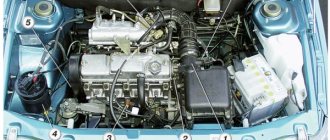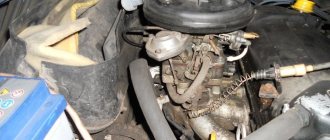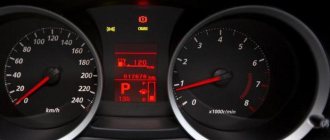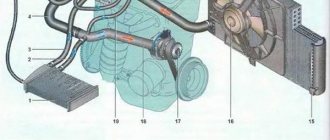As you know, there are constant disputes among car enthusiasts regarding warming up the engine before driving, the operating temperature of the internal combustion engine and the speed at which it reaches the required heating. However, most motorists continue to warm up their engine every morning. Accordingly, from time to time with some regularity the question arises about why the engine takes a long time to warm up.
The engine takes a long time to warm up - when should you be nervous?
It is quite possible that the engine takes a long time to warm up due to the fact that the car has such design features. For a VAZ 2107, for example, it will be difficult to move away in cold weather if the car does not run in warm-up mode for up to 5 minutes. The same story applies to old VAZ 2114 engines and many other representatives of this manufacturer. You need to worry about the condition of the car if there are such features:
- Previously, the engine warmed up much faster, but now to start normal operation you have to stand for long minutes and listen to the uneven revolutions of the unit and the dead temperature needle;
- when warming up, unprecedented symptoms began to appear - the speed fluctuates too much, the voltage in the on-board network drops, the car stalls or other anomalies occur;
- when you start driving, you feel a significant lack of power, the engine tries to pull out under load, it seems that you are dragging a heavy trailer behind you;
- when starting, you have to turn the starter for too long, warming up occurs at low speeds, the engine constantly works as if under a heavy load, and the consumption is simply enormous;
- The engine does not reach operating temperatures even after several hours of operation; this also indicates problems that should be eliminated for a normal trip.
Of course, you should not compare the summer heating mode and winter operating options, since the seasonal behavior of the machine can change greatly. But in case of such problems, along with prolonged warming up of the engine, it is worth contacting a service station. The problem is that many such troubles can have a negative effect on the operation of the car, reduce its efficiency and shorten the potential service life of many parts of the unit.
Last tip
If you still look for the reason for what is happening to your engine - no, because of reluctance or lack of ability - look for smart specialists! There is no point in going to dealerships. The specialists who work there will not help you due to the fact that they are not trained in more than maintenance and pre-sale preparation.
As you know, there are constant disputes among car enthusiasts regarding warming up the engine before driving, the operating temperature of the internal combustion engine and the speed at which it reaches the required heating. However, most motorists continue to warm up their engine every morning. Accordingly, from time to time with some regularity the question arises about why the engine takes a long time to warm up.
Read in this article
Main reasons - looking for problems during long warm-up
There can be quite a lot of reasons. They are not always hidden in the units and components of the machine; sometimes the quality of service becomes a more serious precondition. To correctly find the problem, you should check all possible breakdowns and make sure there are no minor troubles. It is quite possible that you can fix this problem without visiting a service station. Here are important ideas to check when this problem occurs:
- incorrectly selected antifreeze or poor quality of technical fluids in the car’s cooling system, this causes various problems with the warming up process;
- unsuitable or low-quality oil - if the viscosity is too high, the lubricant hardens, and the engine cannot gain normal speed and generally warm up adequately in winter;
- failure of temperature sensors - this could be a thermostat opening sensor or a sensor showing the temperature on the instrument panel, they should be checked first;
- thermostat - it is quite possible that the device is stuck in the open position, in which case the liquid will constantly circulate in a large circle, cooling in the radiator;
- air and ice plugs in the cooling system - plugs often prevent fluid from circulating, which creates an extremely unpleasant effect for the engine and the driver of the car.
In VAZ cars, the problem of prolonged engine warm-up is often associated with the thermostat. You should not install Chinese analogues; they will break down before you even have time to enjoy a normal car ride. But factory products last longer, but require high-quality coolant. So, often the problem with warming up a car is tied precisely to the quality of its service and the high cost of purchased materials.
Checking the functionality of the thermostat
The design of the device implies sensitivity to changes in temperature. The pressure in the coolant system does not affect the restriction of antifreeze circulation through the small circuit, cylinder head and block cooling space. As the temperature difference between the engine and the environment increases, the thermostat gradually opens the coolant supply from the main radiator to the engine.
The same thing happens when the difference in indicators decreases. This process helps maintain and limit the temperature limit of the engine, as well as heat the interior of the car. To determine if the thermostat is working properly, you do not need to remove it.
You can detect a breakdown manually when starting the engine. When it has warmed up for 5 minutes, you can check the device.
Starting will cause coolant to circulate through the engine's cooling passages. Heating of the coolant begins in the engine and radiator of the car. The pipe going in the opposite direction from the radiator to the engine should not be hot. If this happens, then there is a problem with the thermostat.
What are the consequences of poor engine warm-up before driving?
Many will say, so what if the engine doesn’t heat up to the required temperatures? After all, the car drives, and sometimes not worse than at operating temperatures. The issue of warming up is incredibly important for the normal operation of the car, and there are many explanations for this. It is not for nothing that the manufacturer sets the operating temperature range of the unit with an accuracy of a degree; this is an important indicator for the long service life of the motor and the preservation of its characteristics. These are the problems you can get with incomplete warming up:
- Failure of the cooling system. Sensors, thermostat and other parts are designed to operate normally at certain temperatures. Deviations can be caused by various phenomena.
- Wear of engine parts. You'll feel it when it's time to do major renovations. And this time will come quickly enough if the engine operates at low temperatures.
- Increased fuel consumption. On domestic engines, when operating at low temperatures, consumption can increase to obscene figures, and this greatly impacts the owner’s pocket.
- Reduced engine power. Along with the increase in consumption, there is the problem of a significant increase in the load on the parts, and therefore the efficiency of the engine decreases.
- Risk of expensive breakdowns. In addition to simple wear and tear, you also run the significant risk of a seized motor or other unpleasant consequences, which are very real and happen every day in Russia.
Special climatic conditions in the Russian Federation force us to pay special attention to the operation of the car. Otherwise, within a few years after purchasing a new car, you will have a pile of scrap metal, destroyed by domestic climatic conditions. And the issue of warming up the power plant is one of the most serious in terms of the duration and quality of operation of one of the most expensive components in a car.
Radiator
If, when inspecting the hoses, no problems are found and everything is dry, we move on - the radiator. Radiators often have defects caused by engine overheating. Such situations occur more often in the summer, but the consequences appear in the winter. In the heat, in a traffic jam, the engine begins to warm up and does not have time to be cooled by the flow of incoming air (there is none), the temperature rises and the expansion tank may not have time to relieve excess pressure in the system through the plug; accordingly, a microcrack (and more than one) appears in the radiator, which is not visible, but coolant may leak through it.
Moreover, the property of the liquid is such that it greatly changes its density when the temperature changes and begins to flow through small holes only in a cold state, that is, in the summer this problem may not manifest itself at all. A problem with a faulty radiator can be diagnosed by the presence of fluid under the front bumper, and localized and a solution can only be made on a lift or pit. Now a special additive is introduced into the coolant, which glows in ultraviolet light and the location of its leak can be easily and quickly detected thanks to this effect.
Driving on a cold engine and possible consequences
In the previous paragraph, we described what problems can arise if you operate the car on an unheated power unit. Now we will describe the technical process that contributes to the wear of the unit. By the way, many European manufacturers today recommend warming up the car for only 30 seconds or a minute. They deliberately give harmful advice so that the car owner gradually kills the power unit and soon comes to the official dealer for a new engine. It also allows companies to manipulate vehicle environmental standards.
So, with just a minute of warming up, you start driving on a cold engine. The gaps in the piston system are increased, microvibrations occur as the piston passes through the working part of the block. Because of this, the piston and block become covered with micro-scratches due to improper contact. The higher the speed at this moment, the more damage the unit will have.
Also, during a cold trip, the engine receives increased loads, since it cannot yet produce peak torque. If you decide to spare the engine and drive at low speeds, say in third gear, the engine will suffer maximum damage due to the high load. Vibrations will be heard even in the cabin, which lead to the destruction of the piston group.
Warming up the engine to 40 degrees is the only way to significantly reduce engine wear when starting to drive. Of course, you don’t need to warm up the engine to 90 degrees before driving. It is quite enough to wait until the temperature needle breaks away from its initial position and begins to move along the scale.
What to do if your car overheats in a traffic jam
When driving a car for a long time in a lower gear, the engine operates with increased power, which in itself leads to overheating.
Add to this the lack of counter-flow of air necessary to cool the radiator. What to do? The main thing is not to panic. Short-term overheating is not terrible, but if you see that the car is not cooling down, it’s time to act. Important - do not turn off the engine unless absolutely necessary. Exactly - without extreme
A stalled, overheated engine is an almost 100% guarantee of repair. It will take quite a long time to describe what is happening in the engine in this case (rotating the liners together with the crankshaft, when the engine is subsequently started - the least of the possible troubles), just take it on faith.
Important - do not think about pouring water on the engine or pouring cold water into the radiator. The result is the same - repair
Moreover, you can try so hard that you cannot do without replacing the block and cylinder head. Another “beauty” of cold water is microcracks inside the block. Finding and eliminating will be very, very difficult, if not impossible. The car has overheated - try to pull over to the side of the road. If it doesn’t work out, don’t panic and don’t pay attention to those around you – it’s important for you to save the engine. Stop at idle, turn the heater on full, and wait. If after 5-10 minutes the situation does not improve, turn off the engine. It’s a good idea to open the hood; the main thing in a panic is not to forget to set the car’s parking brake.
The only reason to turn off the engine right away is clouds of steam coming from under the hood. Most likely, the cooling pipe has burst, and further operation of the engine will only worsen the situation.
This is what it looks like, engine overheating, if you look closely. Now you know why the engine gets hot and how to deal with it.
The air in the cabin does not heat up for a long time - what is the reason?
Another big problem with warming up a car for a long time in winter is that it takes too long for the air in the cabin to warm up. You have to drive with terribly cold air from the air deflectors, scrape ice off the glass in the cabin and encounter various other troubles. Therefore, solving this problem is often a priority. It is worth paying attention to several possible reasons for this unpleasant effect:
- general problems with warming up the engine, which we discussed above, because if the fluid is not warmed up, then cold air will enter the cabin, this is an inevitable consequence;
- blockage in the cooling system - there may be air pockets in the stove itself, which do not in any way affect the quality of operation of the rest of the system; they can be eliminated at service stations;
- problems in the heater radiator - often the radiator itself is the cause of problems, it can be clogged, dirty inside or outside, which causes the effect of cold air in the cabin;
- clogged air ducts - often the problem of foggy glass and cold in the cabin is connected, it is worth cleaning the air ducts and inspecting them by removing the front panel and other parts in the cabin;
- broken switches and regulators - often car owners come to service stations who do not suspect that the temperature in the cabin is cold due to a non-functioning temperature control knob.
These are the unusual reasons that can occur when the interior is poorly heated. As a rule, such problems also include fogging and icing of the windows in the cabin, terrible stale air during a long trip, unpleasant odors, high humidity and even dampness. Such effects will clearly not benefit your car, nor will they provide a pleasant experience when using the vehicle. So you should get rid of them as soon as possible.
Watch a video on how to check the thermostat's operation:
What can be done?
If the car is not warming up well, you can inspect the thermostat yourself.
Removing the air tube
The main reasons for poor heating in winter include air lock. It is useful for a car driver to have the knowledge and skills to remove air from the system. Its accumulation occurs at the highest point - the throttle assembly. From there you need to remove the air plug. The sequence of actions is as follows:
- Unscrew the filling cap on the engine, remove the screen and screw the cap into place to avoid contamination of the crankcase.
- Find 2 pipes, which are located side by side in the throttle assembly, and pull out 1 of them.
- Open the coolant expansion tank and cover it with a clean cloth.
- Blow slowly into the tank until antifreeze flows out of the hose.
- Put the tube back on and tighten the clamp quickly so that no air gets into the pipe.
This scheme is suitable for the VAZ 2114. When clogging of the cooling paths occurs frequently, check the entire system, which may be depressurized. If after these steps the engine temperature does not rise, then you need to look for another source of problems.
Engine insulation
By insulating the engine, you cannot get rid of all problems with warming up. If the engine is properly insulated, it will not require prolonged warming up during the day, and the coolant temperature will be normal. To insulate domestic equipment, heat-insulating material is installed between the radiator and the front grille. The motorist can use cardboard or buy special insulation.
In a purchased product, the padding consists of synthetic insulation covered with a leather substitute. It has the advantage of special holes that open when the temperature rises. Insulation can be achieved by installing a heat insulator under the hood. Special blankets have been developed for this purpose.
You can buy them or make them yourself from felt, mineral wool or other material. This type of thermal insulation helps prevent a layer of ice from freezing on the hood, which often happens in winter when snow falls on the car, melts and freezes. The heat insulator can be glued to the lower engine protection. In the future, it will need to be cleaned of dirt so that it does not get into the engine.
Let's sum it up
Considering the importance of the issue of warming up the car, it is worth paying special attention to the operating features of the unit. If you notice problems with the operating temperature, a slow increase in the temperature gauge, or with other aspects of the unit’s operation, it’s time to go to a service station or sort out the problems yourself. Such problems can be caused by dozens of reasons, and it is worth understanding them all to get a decent answer to the question. Sometimes there are combinations of negative factors in a car that enhance the effects of this problem.
It is best to have your vehicle serviced by specialists, but you can also find many reasons for such problems on your own. Diagnostics is difficult, but possible even in a garage. Using trial and error, in a few hours you can find the culprit of poor engine warm-up, change parts and restore the operation of the power unit. This is true for domestic cars, but in this case it is better not to repair foreign cars yourself. This approach may force you to spend even more money on further maintenance. Have you ever encountered poor engine heating in a car?
conclusions
The causes of heating and overheating of a 16-valve engine have been identified and elimination methods have been discussed. Thus, untimely repair of this unit can lead to the fact that the engine will finally fail and will need to be replaced. Therefore, if the first signs appear that the cooling system has failed, it is necessary to find and eliminate the cause, since a replacement will be much more expensive.
HomeCarsVAZ
Overheating of a car engine is a problem that every driver may encounter. In this article we can find out:
- how to notice in time that the engine has overheated;
- why the engine gets hot in general and in certain situations;
- what to do if the engine overheats.
To understand the essence of the issue, it is necessary to consistently read all the explanations of an experienced auto mechanic.
What actions to take to troubleshoot problems
The simplest way is to replace the faulty device. But on early brands of domestically produced equipment, even new thermostats do not always cope with their function when the engine temperature systematically drops while driving.
The cause of the trouble is the imperfection of its design. There is a way to install more advanced regulators. They are installed on the tenth VAZ model. This thermostat is equipped with six holes, is capable of effectively maintaining the engine temperature in winter, and is collapsible. In the future, you will not need to replace the entire assembly, only the faulty elements. Moreover, in the summer, the operation of thermostats is no different.
Getting started with the car
One of the important nuances when operating a car is preparing it for movement. First of all, this applies to working with the engine. First, before starting to move towards the intended goal, it is necessary to prepare the engine for its active operation during movement, that is, it should be warmed up. After a long period of inactivity, which is a period of more than 3-4 hours in summer, and 1-2 hours in winter, the engine temperature drops to a minimum value. In order to avoid many problems, you need to start the car and wait until the engine temperature sensor reaches at least 50 degrees. If you like to drive a cold engine, then be prepared for increased oil consumption, which in turn will lead to faster engine wear and additional costs for consumables.
Drivers often face the problem of taking a long time to warm up the engine, especially in winter. Waiting takes up a lot of time, and you don’t really want to sit, for example, in a cold car in winter. In this case, it is worthwhile to figure out why the engine takes a long time to heat up and whether this is a consequence of any malfunction in its operation.
Similar article - Why do car windows fog up?
Effect of motor oil
As you know, engine performance depends on the quality of the oil. The degree of heating of the engine will depend on this, especially in winter. Depending on what kind of oil is used (synthetic or semi-synthetic), the engine may heat up differently, and the range of fluctuations in coolant temperature will be from 5 to 20 degrees.
Depending on how liquid the motor lubricant is, how well and quickly the engine will start in winter, as well as the degree to which it heats up quickly. Therefore, it is recommended to fill only high-quality oil into the engine before winter.
Insufficient coolant level
This is now unlikely, because many modern cars have antifreeze level sensors. However, such cases do occur (say, in cars of previous generations). Imagine - the antifreeze or antifreeze (maybe due to leaking radiators or pipes), the heater does not receive enough heated liquid, and it is practically cold, the fan is blowing, and the air from the heater is cold (it simply does not heat). You need to add coolant to the level ( read how to do this here ). Also, if radiators or pipes are leaking, then the leak must be eliminated.
It is worth noting that when the coolant leaks, “air plugs” may form, so even if you add antifreeze - antifreeze, you need to wait a while for the air to come out.
Which system is responsible for maintaining a constant engine temperature?
No vehicle is insured against breakdowns. Car components and assemblies consist of many small components, the functional life of which has significant limitations. If a car owner notices that the temperature of the internal combustion engine is dropping while driving, he needs to pay close attention to the integrity of the cooling system elements. This is where the causes of the problems lie.
The essence of the cooling system is the movement of a special liquid - antifreeze through two technological circles. One of them is small and does not provide for the passage of coolant through the cooling radiator located in the front part of the engine compartment. It is limited to circulation only along the “shirt”.
The passage of a large contour begins to occur when driving over medium and long distances. A special thermostatic valve is responsible for switching circles, opening the path for coolant into the radiator when it gets too hot. There the antifreeze cools down and returns to the system already cold.











